
The Prinsengracht is a 3.2-kilometer (2.0 mi)-long canal that runs parallel to the Keizersgracht in the center of Amsterdam. The canal, named after the Prince of Orange, is the fourth of the four main canals belonging to the canal belt.
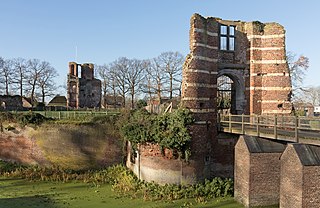
Batenburg is a city in the municipality of Wijchen, in the Dutch province of Gelderland. It is located on the Meuse, about 15 km west of Nijmegen. It is well known for the remains of a medieval fort in the center of the town. Batenburg received city rights in 1349. Until 1984, Batenburg was a separate municipality.

A visual pun is a pun involving an image or images, often based on a rebus.

The Jordaan is a neighbourhood of the city of Amsterdam, Netherlands. It is part of the borough of Amsterdam-Centrum. The area is bordered by the Singelgracht canal and the neighbourhood of Frederik Hendrikbuurt to the west; the Prinsengracht to the east; the Brouwersgracht to the north and the Leidsegracht to the south. The former canal Rozengracht is the main traffic artery through the neighbourhood.
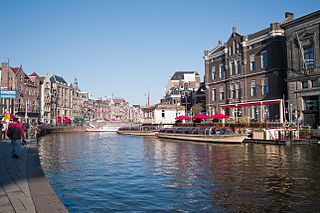
The Rokin is a canal and major street in the centre of Amsterdam. The street runs from Muntplein square to Dam square. The Rokin canal used to run from Muntplein square to Dam Square, but in 1936, the part between Spui square and Dam Square was filled in. Canal boats are now moored on the remaining part of the water, from the Amstel to Grimburgwal.

The Anne Frank House is a writer's house and biographical museum dedicated to Jewish wartime diarist Anne Frank. The building is located on a canal called the Prinsengracht, close to the Westerkerk, in central Amsterdam in the Netherlands.

Österlånggatan is a street in Gamla stan, the old town of Stockholm, Sweden. Stretching southward from Slottsbacken to Järntorget, it forms a parallel street to Baggensgatan and Skeppsbron. Major sights include the statue of Saint George and the Dragon on Köpmanbrinken and the restaurant Den Gyldene Freden on number 51, established in 1722 and mentioned in Guinness Book of Records as one of the oldest with an unaltered interior.

Amsterdam, capital of the Netherlands, has more than 100 kilometers (62 mi) of grachten (canals), about 90 islands and 1,500 bridges. The three main canals, dug in the 17th century during the Dutch Golden Age, form concentric belts around the city, known as the Grachtengordel. Alongside the main canals are 1550 monumental buildings. The 17th-century canal ring area, including the Prinsengracht, Keizersgracht, Herengracht and Jordaan, were listed as UNESCO World Heritage Site in 2010, contributing to Amsterdam's fame as the "Venice of the North".

The Grachtengordel, known in English as the Canal District, is a neighborhood in Amsterdam, Netherlands located in the Centrum district. The seventeenth-century canals of Amsterdam, located in the center of Amsterdam, were added to the UNESCO World Heritage List in August 2010. The Amsterdam Canal District consists of the area around the city's four main canals: the Singel, the Herengracht, the Keizersgracht, and the Prinsengracht. From the Brouwersgracht, the canals are generally parallel with one another, leading gradually southeast into the Amstel river.

Negen Straatjes is a neighbourhood of Amsterdam, Netherlands located in the Grachtengordel, a UNESCO World Heritage Site.
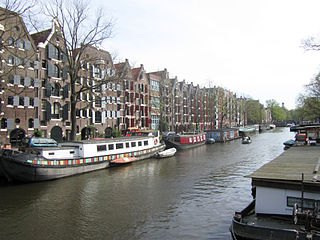
The Brouwersgracht is a canal in Amsterdam that connects the Singel with the Singelgracht. The canal marks the northwestern border of the Grachtengordel. Between the Prinsengracht and the Singelgracht the Brouwersgracht forms the northern border of the Jordaan neighborhood.

The Wijnkopersgildehuis is a former guildhall in Amsterdam. The 17th-century double house is located at Koestraat 10–12, near Nieuwmarkt square. It is one of the few remaining guildhalls in Amsterdam and has the oldest known neck-gables. The building has rijksmonument status.

The Waag is a 15th-century building on Nieuwmarkt square in Amsterdam. It was originally a city gate and part of the walls of Amsterdam. Later it served as a guildhall, museum, fire station and anatomical theatre, among other things.

The Amsterdam Pipe Museum is a museum in Amsterdam, the Netherlands, dedicated to smoking pipes, tobacco, and related paraphernalia. It holds the national reference collection in these areas.

Leather wallpaper is a type of wallpaper used in various styles for wall covering. It is often referred to as wrought leather. It is often gilded, painted and decorated. Leather was used to cover and decorate sections of walls in the houses of the rich, and some public buildings. Leather is pliable and could be decorated in various ways.
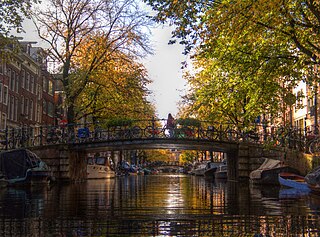
The Egelantiersgracht in Amsterdam is a canal in the Jordaan neighbourhood in the Amsterdam-Centrum borough. The canal lies between the Prinsengracht and the Lijnbaansgracht.

The Bloemgracht is a canal in the Jordaan district of Amsterdam, the Netherlands. It connects the Prinsengracht with the Lijnbaansgracht and runs between and parallel to Nieuwe Leliestraat and Bloemstraat in the Amsterdam-Centrum district. The canal is named after the bulwark "de Bloem", later called "Rijkeroord". From 1614 a windmill was located here, but it was moved to Haarlemmerweg in 1878.
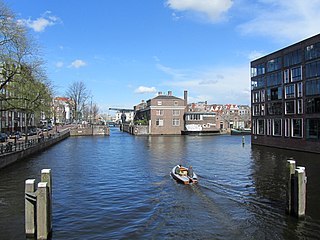
The Nieuwe Herengracht is a canal in Centrum district of Amsterdam. The canal is an extension of the Herengracht that runs between the Amstel and the Scharrebiersluis (lock) leading to the Schippersgracht from the Entrepotdok. It is in the Plantage neighborhood in the eastern part of the Grachtengordel.
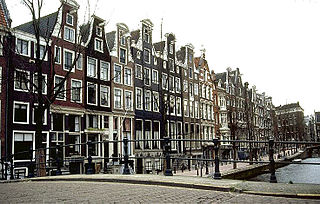
The Leidsegracht is a canal in Amsterdam, Netherlands. It is a cross-canal in Amsterdam-Center that connects Herengracht, Keizersgracht, Prinsengracht and Lijnbaansgracht and flows into the Singelgracht at Marnixstraat.

The Oudeschans, or Oude Schans, originally the Nieuwe Gracht, is a wide canal in the eastern part of the inner city of Amsterdam.
























